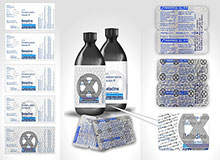

An underrated danger: language barriers and worn off expiration dates
It seems that the danger of expired medicines is underrated and that other challenges when deciphering the expiration date come into play. Factors such as prolonged illness and increased health-care costs are just some of the things that are associated with ingesting medicine that is out of date.
Kanupriya explains: "The current solution of imprinting the expiration date on medicinal packaging is ineffective for multiple reasons: the choice of language for indicating the expiration date is English, which is not the first language in several parts of the world; the expiration date can be difficult to find and read due to the size of the font and the printed date often wears off with time or gets removed as the packaging is used or torn (as in the case of medicinal strips)."
To ensure that expired medicine is not accidently consumed, Kanupriya states: "We wanted the packaging material itself to be as informative as the universally accepted symbols and signs such as the danger sign or traffic lights, which impart the same message across cultures. The intent was to come up with a packaging material on which its expiration information was not dependent on language literacy, or finding the expiration date or reading of any kind."
A universal language: visual changing paper
To materialise the concept of self expiring medicine, Kanupriya decided to use the idea of visually changing paper. She says: "We propose a paper, which comprises of various layers that bleed ink in a fixed time lapse to the layer above. Depending on the time frame of expirations these layers could be increased or decreased and programmed to display the expiration message on the topmost layer of packaging alerting the user of the expiration of the medicine."
Their design packaging means that even those with ailments such as limited vision, or those who are illiterate, will still be able to protect themselves from potentially harmful substances.
"We believe having the expiration message appear graphically on the packaging will enable the user to understand when to stop using it, and lift off the huge burden of consumption of expired medicines and health repercussions due to the same," Kanupriya explains.
Creating awareness: educating consumers about the side-effects
While researching the problems that expired medicine can cause, they also found that many people did not understand the dangers of taking the medications.
"We performed ethnographic research of focused groups in India, like the elderly population, construction workers, slum dwellers, kids between ages 6-12 and realised that in many cases people were not aware of the concept of expiration of medicines," states Kanupriya.
"We realised in India the medicinal strips had the expiration information stamped in one corner. In the event when these strips were sold as per dosage, the expiration information would be missing. In some cases it was observed the retailers selling expired medicines cheaper to earn their profits. We wanted a solution that could solve the problem, and create awareness at all levels."
By using the already existing technology of visually changing paper, the designers used this to create the packaging materials that will ‘self expire’ over the specific elapsed period of time.
Kanupriya explains the time-controlled release process: "This packaging will be made of inexpensive label-like materials. It will have a two-component design where the foreground label will initially display the medicine information on a solid plain white background. The second component consists of the layer carrying the hidden message."
She adds: "These two layers will be separated by multiple sheets of diffusible material through which the ink from the hidden message will seep through as time lapses. The number of sheets will allow us to control the rate of diffusion of the hidden ink such that the ‘not fit for consumption’ message is revealed only at the time of expiration."
Relieving the burden: saving patients from prolonged illness and fatalities
The potential of this technology appears to be promising with the advantages being evident.
"We would envision this idea to be adopted and enforced by FDA and pharmaceutical companies," she says. "This idea if made a norm in medicinal packaging can save patients from prolonged illness and fatalities arising from the consumption of expired medication. It will also prevent retailers and black marketers from making profit off of selling expired medications to their less aware and illiterate consumers."
The innovative packaging means that any obstacles that non-English speakers or people with limited visual capabilities have will be completely diminished. Kanupriya believes it is a necessity because "the ability of the packaging to alert the user visually, after an elapsed time interval, takes significant burden off the users."
By providing and directing the user with expiration information the packaging could significantly minimise any future health care challenges.
"The users would not have to wonder about the expiration even when they are down to the last tablet because the expiration information will be contained in the entire packaging and not just at a specific corner or a location of the label," she explains.
Rather it will "prevent many retailers in India from illegally selling any expired medications for personal gains. This solution may prove to be more efficient and widely understood by the illiterate and the unaware to prevent accidents and fatalities arising from consumption of expired medicines."
Follow Sonia Sharma on Google+



